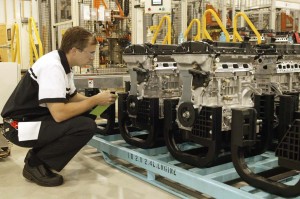
Will Chrysler boot partners Hyundai and Mitsubishi out of the Global Engine Manufacturing Alliance?
With its new parent, Fiat, calling the shot, it’s looking like Chrysler may be ready to make some major changes in direction, notably by eliminating a variety of joint ventures with potential competitors.
Earlier this week, TheDetroitBureau.com reported that Chrysler was calling off a multi-pronged project with Nissan. Among other things, Chrysler would have supplied the Japanese maker with a version of its Dodge Ram pickup to serve as a replacement for the slow-selling Nissan Titan. Now comes word Chrysler could be ready to pull out of the Global Engine Manufacturing Alliance.
The four-year-old partnership with the Korean carmaker Hyundai and Japan’s Mitsubishi, got into production in October 2005, the $803 million factory, in Dundee, Michigan, producing a variety of small Hyundai-derived inline-four-cylinder engines for use in products such as the Jeep Compass.
Chrysler has removed the logos of its erstwhile partners from the entrance to the facility, reports The Detroit Free Press, a move confirmed by TheDetroitBureau.com’s own sources. But it is not yet clear if there might be another reason for such a move.
“We have nothing to announce, yet,” a Chrysler spokesperson said, a comment that seemed to suggest a statement might indeed be forthcoming. Attempts to contact the other two makers have so far been unsuccessful.
The GEM project was originally conceived in 2003, while Chrysler was the second-tier partner in DaimlerChrysler AG. At that time, the German side of DCAG was in aggressive expansion mode and had been looking to form other ventures with both Hyundai and Mitsubishi. But with the departure of DaimlerChrysler’s first CEO, Juergen Schrempp, DCAG began backing away from his ambitious global goals, with GEM the only critical piece remaining.
Chrysler retained its stake in the highly-automated, 1.16 million square foot Dundee facility when that trans-Atlantic company broke up, two years ago. About 400 workers are split into four 10-hour shifts at the factory, and each must have a minimum of a two-year degree and trade certification or five years in advanced, computer-based manufacturing. As with Chrysler’s Jeep Wrangler plant, in Toledo, much of the work at Dundee is actually done by the automaker’s suppliers, a strategy designed to outsource employment-related costs, among other things.
Counter to original plans, Chrysler has been the only user of the engines coming out of Dundee, which might explain its desire to bring the operation entirely in-house. Nonetheless, with its’s sales off by a third, so far this year, it’s unclear why the company might want to oust the partners that help share the GEM project’s costs. But it appears that, going forward, Chrysler will put more of an emphasis on small and mid-size passenger cars, rather than the light trucks that have long dominated its line-up.
Fiat has already indicated it would like to produce a North American version of its pint-sized Cinquicento, or 500, minicar, which could conceivably make use of one of the 1.8, 2.0 or 2.4-liter I-4 engines built at Dundee.
